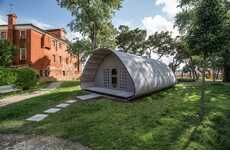
Parachute Shelter Delivers Tents from the Air to Victims on Broken Ground
Amelia Roblin — March 20, 2012 — Art & Design
References: tuvie
A refuge with something resembling a roof and walls is vital for the safety and comfort of human lives -- especially amidst the volatile environment following a natural disaster. The Parachute Shelter project proposes a clever way to deliver safe havens and supplies to victims of earthquakes, hurricanes and floods with a system of canopy-strapped packages dropped from relief airplanes.
Designers Kwon Do-hyuk, Lee Bum-ho, Kim Seok-woo, Seo Dong-han, and In Sung-hoon intelligently avoided any reliance on potentially damaged roads, allowing tents and provisions to be delivered to specific locations with accuracy and efficiency by planes and helicopters. The innovative refuges are actually the umbrellas that break the fall of their suspended armored boxes. The Parachute Shelter is consequently an assembly-free emergency abode that comes with a crate of clothing, blankets, food, water and First Aid equipment.
Designers Kwon Do-hyuk, Lee Bum-ho, Kim Seok-woo, Seo Dong-han, and In Sung-hoon intelligently avoided any reliance on potentially damaged roads, allowing tents and provisions to be delivered to specific locations with accuracy and efficiency by planes and helicopters. The innovative refuges are actually the umbrellas that break the fall of their suspended armored boxes. The Parachute Shelter is consequently an assembly-free emergency abode that comes with a crate of clothing, blankets, food, water and First Aid equipment.
Trend Themes
1. Aerial Relief Delivery - The Parachute Shelter project demonstrates the potential for using airplanes and helicopters to deliver emergency supplies and shelters to disaster-stricken areas, bypassing damaged roads.
2. Canopy-strapped Packages - The use of canopy-strapped packages in the Parachute Shelter system offers a secure and efficient method of delivering supplies and shelters to specific locations.
3. Assembly-free Emergency Abodes - The concept of assembly-free emergency shelters, like the Parachute Shelter, provides victims of natural disasters with immediate and accessible refuge.
Industry Implications
1. Emergency Response - The Parachute Shelter project presents innovation possibilities within the emergency response industry, particularly in terms of aerial relief delivery.
2. Logistics and Supply Chain - The use of canopy-strapped packages in disaster relief efforts highlights potential advancements in logistics and supply chain systems.
3. Design and Manufacturing - The development of assembly-free emergency abodes can disrupt the design and manufacturing industry, providing new opportunities to create efficient and scalable emergency shelters.
1.7
Score
Popularity
Activity
Freshness























